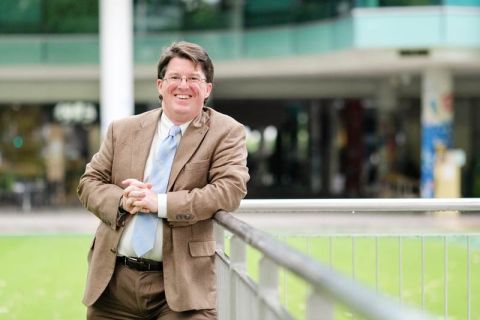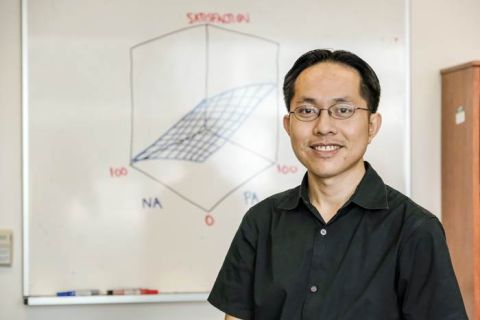
Back to Research@SMU Issue 44
By Rebecca Tan
SMU Office of Research & Tech Transfer – In 2001, Singapore authorities uncovered a plot by members of the Jemaah Islamiyah terrorist group to bomb the Yishun mass rapid transit station, among other targets. Since then, Singapore has been on the alert, regularly reminding commuters to report any ‘suspicious-looking’ people or objects.
While such public awareness initiatives are important, it would still be better to nip the problem in the bud and identify would-be terrorists before they act. The problem is that terrorist groups are extremely diverse; their wildly differing methods and motivations make it difficult to predict when a particular group will strike next.
Existing methods to profile terrorist organisations typically rely on assumptions about characteristics perceived to be important, such as ideology, targets and tactics. Instead, Assistant Professor Michael Genkin, a sociologist at the Singapore Management University (SMU) School of Social Sciences, uses data to decipher deviant groups.
“My research is focused on social networks, terrorism, and how the two overlap,” Professor Genkin shares. “For this third area, I’m interested in how network-based processes explain terrorism, particularly using quantitative or statistical techniques.”
Unveiling the unseen
Like any other organisation, terrorist groups are social networks, albeit ones that are not as transparent as your list of friends on Facebook or Twitter.
“A big problem in the study of terrorist networks is how one codes ties. Oftentimes you don’t have information on direct linkages, you just have snippets or clues of who is connected to whom,” Professor Genkin explains.
“Some ties are very clear. For example, two people participating in the same attack are very likely to know each other. But sometimes all you know is that person A and person B were in the same apartment block. Then we have to see if we can draw conclusions about whether there is a tie by using stricter criteria to test the network assumptions and seeing if our results hold.”
Professor Genkin does this with a technique called graph database analysis, a relationship mapping tool more commonly used by computer scientists and engineers. While conventional social network analysis methods are more tedious because they require the entire network to be recoded each time there is new information, graph database analysis can project networks very quickly because of the comprehensive way in which information is coded.
In a study published in Social Networks titled ‘A graph database framework for covert network analysis: An application to the Islamic State network in Europe’, Professor Genkin used graph database analysis to compare different terrorist organisations, in particular Al-Qaeda and the Islamic State (ISIS).
An ideal terrorist network would theoretically find a balance between efficiency and security, forming groups where command and control can be done quickly but also securely. If an organisation is too secretive, executing attacks and leveraging one’s manpower would be difficult; on the other hand, if everyone knows everyone else, a single person caught could give away the whole team, he explains.
“One of the interesting findings is that in practice, these networks don’t follow the ideal structure. Instead, because of various sociological processes, people talk to each other and have links that are redundant and unnecessary, inadvertently making the organisation vulnerable,” Professor Genkin says.
“In particular, we found that the ISIS network that carried out the 2015–2016 attacks in Paris and Brussels had a relatively unsecure structure with many such redundant ties. So how were they able to organise and carry out the attack without getting caught? What we think may have happened is that ISIS relied on popular messaging apps that have state-of-the-art encryption, which gave them very secure communication. The authorities could not intercept their messages, allowing them to attain both efficiency and security.”
Making and keeping members
Professor Genkin has also studied a different kind of trade-off, one that all organisations – terrorist or not – face: recruitment versus retention. In a study published in the American Sociological Review titled ‘A Member Saved Is a Member Earned? The Recruitment-Retention Trade-Off and Organisational Strategies for Membership Growth’, he examined the tension that exists between firms focusing on recruiting new members and on retaining existing ones, and the role that social networks play in this trade-off.
“One way to recruit new members is to encourage existing members to socialise, but this increases the risk that they might leave for other organisations. On the other hand, forbidding all socialisation with people outside the group maximises retention but makes it hard to recruit new members,” he explains.
“The question is which strategy should an organisation pursue in order to grow and survive among competing organisations that are themselves facing the same dilemma?”
Using agent-based modelling, Professor Genkin and colleagues showed how the recruitment-retention trade-off depends on the network structure that organisations create among their members. Two dimensions are critical: the extent to which organisations induce social interaction among members, and the extent to which they demand energy and time from their members. The right balance for a given organisation, the researchers found, depends on the strategies of the organisations it competes with for members.
Typologies and ties
Terrorist groups are extremely varied, says Professor Genkin. “The problem is that we often talk about ‘terrorism’ in the generic sense, without appreciating the different types of terrorism that exist. A claim may be true for one type of terrorist organisation but not for another. Meanwhile, existing typologies of terrorist groups are not very predictive,” he explains.
To address this, Professor Genkin has used a unique dataset of terrorist organisational features and events to develop a new typology that is able to classify terrorist organisations based on a relatively small number of attributes.
Professor Genkin is also collaborating with Assistant Professor Nicholas Harrigan, a colleague from the SMU School of Social Sciences, to study intergroup dynamics. Noting that intergroup conflict has primarily been studied by psychologists without taking network mechanisms into account, both of them intend to study how the interplay between positive and negative ties contributes to both increasing as well as attenuating intergroup conflict.
“Ultimately, most social processes happen through networks. This is why considering factors that influence network ties and network dynamics is far more important than looking at individual factors per se. In my view the networks lens is very revealing if one wants to understand terrorist and other organisations,” he concludes.
Back to Research@SMU Issue 44
See More News
Want to see more of SMU Research?
Sign up for Research@SMU e-newslettter to know more about our research and research-related events!
If you would like to remove yourself from all our mailing list, please visit https://eservices.smu.edu.sg/internet/DNC/Default.aspx

